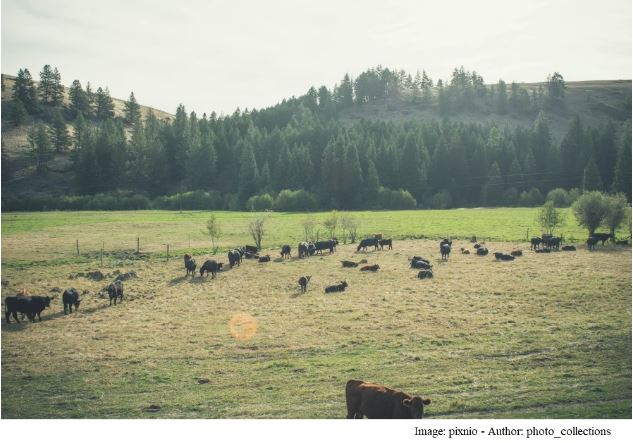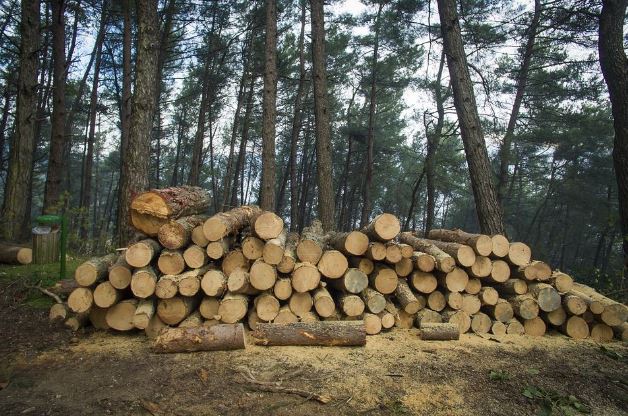Last updated: Nov 02, 2024

We have been so swift to identify and capitalize on all the uses and financial gains to be made out of forests.
But what’s our reckoning on the priceless relationship of forests to the web of life?
How do we even begin to measure the value of oxygen & clean air, clean water, healthy climate, diversity of wildlife, and lowered risks from floods, landslides, and avalanches?
Go to a rainforest, and we doubt there is any yardstick to fathom the richness you experience being shrouded by the thick canopy and its grandeur. The soothing greenery, the waterfalls, the chill and refreshing clean air, the awe of wildlife & biodiversity, would certainly give you the realization of being part of something truly magnificent!

Thus let us understand what deforestation is and the leading causes, effects, and solutions for this crisis with facts & examples.
What is Deforestation?
Deforestation is the permanent process of cutting, clearing, and removal of trees, plants, and related ecosystems from a wide area into a less biodiverse ecosystem such as pasture, cropland, plantations, and other uses where the trees are never re-planted.
Forests approximately have 31% coverage of the land area on the planet and 60-70% of the world’s plants and animals live in forests [1] [2]. Unfortunately, most of the threatened and endangered species live in forests and are deprived of their natural habitats due to deforestation.
To make you understand the gravity of the state of affairs, as of 2023, every 2 – 6 seconds a forest area equivalent to an area of a football field is destroyed by human activity. If the current rates continue, we could lose all the forests in a few hundred years! A case of digging our own grave!
Causes of Deforestation
1) Animal Agriculture & Livestock Ranching

Animal agriculture for beef and other related products from animals is one of the top drivers of deforestation [3] [4].
The main causes of this type of deforestation are:
- Clearing of forests for new pasture
- Clearing of forests to grow crops such as soya beans and cereals as feed for livestock (this correlation between animal agriculture and soybean production is another reason why animal agriculture aggravates deforestation)
- Degeneration of grassland due to pasture
The damage is so grave the deforestation caused by animal agriculture is more than twofold compared to the production of soy, palm oil, and wood products which are other major drivers of deforestation combined [5].
The other impact of cattle as pointed out earlier is that it can also convert non-forest landscapes, from grasslands to dead, unproductive land with erosion.
If you look at South America, deforestation due to beef production is even more severe where it was responsible for 71% of total deforestation (including in the Amazon rainforest) between 1990 and 2005, compared to just over 17% for all other commercial & agricultural drivers combined [6].
2) Crop Agriculture

Industrial agriculture and subsistence agriculture (farming by locals for their livelihood) are another substantial driver of deforestation.
The most notable commercial crop agricultural drivers of deforestation include soy and palm oil production.
a) Soybean Production
The biggest driver of deforestation under crop production is soybean production. Only a small percentage of soy is used for human consumption whereas 70% to 75% is used as feed for animal farms. Soy is used as a primary source of protein in livestock feed for cows, chickens, pigs, as well as for farmed fish.
The effect is significantly apparent in Latin America. Due to world’s growing demand for meat and the increased production of soy as feed for cattle, consequently resulted in deforestation and devastating effects on ecosystems.
As far as human consumption is concerned, soybeans are consumed as curry, tofu, soy milk, soy sauce, meat substitutes, and many other soy products.
b) Palm Oil
It is the most widely consumed vegetable oil on the planet and found in everything from our foods, cosmetics, cleaning products to fuels, making it one of the world’s leading deforestation drivers.
It’s a source of huge profits for multinational corporations, where Malaysia and Indonesia being the biggest palm oil producers. Vast strips of forests and carbon-rich swamps are cleared for palm oil plantations which release a great amount of carbon into the atmosphere. This in turn has a detrimental ripple effect on air pollution, global warming, indigenous people, and many endangered species.
c) Subsistence Agriculture
A third to two-fifths of tropical deforestation is due to subsistence activities by local people who use the resources of rainforests for their livelihoods.
Besides cutting trees as building materials, they use the slash-and-burn technique where any wild or forested land is cleared and any remaining vegetation is burned for short-term agriculture. Once the land is infertile they move into a new plot which causes further deforestation. This method of farming seems to be used by about 475 million small farm households worldwide [7}
Subsistence agriculture consists of staple crops like maize, manioc, bananas, palms, rice, and small-scale cultivation of coffee, cocoa, and cotton, while forest degradation occurs due to livestock grazing as well.
d) Tobacco Industry
An estimated 200,000 ha of deforestation is caused by tobacco farming each year and it occurs mainly in the developing world which constitutes 1.7% of forest cover loss or 4.6% of total national deforestation.
Every year about 11.4 million metric tonnes of wood are used as wood fires for the drying of tobacco leaf.
Believe it or not, that’s an equivalent of one tree for every 300 cigarettes and to put it into perspective, in 2012, 967 million daily smokers consumed approximately 6.25 trillion cigarettes worldwide according to a report by WHO [8].
3) Pulp & Paper Industry
Paper is manufactured from tree fibers either from the growing forests or recovered paper. Broad swathes of forest have been cut down to supply paper and a substantial amount of deforestation tends to occur in developing countries, though it is a concerning issue in some developed nations as well.
Unfortunately, countries such as Indonesia, Brazil, and Malaysia don’t seem to have well-regulated programs in place to ensure sustainable forest management.
The two major companies that account for 80 percent of Indonesia’s pulp and paper production are Asia Pulp & Paper (APP) and Asian Pacific Resources International Holdings Limited (APRIL) and these two companies seem to have taken advantage for years from the lack of regulation [9].
4) Logging for Timber

Logging for timber is the process of cutting and processing trees to meet the demand of the world’s markets for furniture, construction, and other wooden products.
Since trucks and large equipment need access into the forest and transport timber, there is a requirement to clear forests for large roadways by loggers.
Although selective logging seems to be an alternative where only one or two species of trees are cut down, it doesn’t seem to help matters due to higher rates of forest fires, thinning of the forest’s protective canopy, and disruption of the ecology.
The importance of forest canopy to the forest’s ecosystem is that it accommodates and protects plants, animals & insect populations, and the forest floor which slows down soil erosion.
Legal and illegal logging both cause forest degradation which results in more than 70% of total forest degradation in Latin America and Asia while in Brazil and Indonesia, approximately 80% to 90% of logging deemed illegal.
5) Mining
Since lucrative resources such as gold, coal, copper, diamonds, gemstones, and other precious metals are found in rainforests, mining for such resources has posed a significant threat to tropical forests worldwide.
Large-scale mining operations can result in substantial deforestation through forest clearing and other mining-related infrastructure such as the construction & expansion of roads. This can then open remote forest areas to temporary settlers, land speculators, and other small-scale miners.
The other threat comes from wildcat gold miners who enter areas in pursuit of wealth, rumored to have gold deposits. They cut trees, detonate explosives, hunt wildlife, and cause erosion by clearing hillsides.
6) Overpopulation
It’s obvious that the rise in population invariably results in a rise in deforestation and so far these two variables have not been mutually exclusive.
According to a report by the United Nations Framework Convention on Climate Change:
- Deforestation attributed to agriculture is approximately 80 percent [10]
- Deforestation attributed to logging is approximately 14 percent
- Deforestation attributed to firewood is approximately 5 percent
- The remaining deforestation is utilized for other purposes
All these human activities which cause deforestation tend to rise with the rise of population.
7) Forest Fires
Wildfires can be considered a cause of nature and a natural element of many forest landscapes, but occurring at the wrong time, place, frequency and intensity can cause devastation.
As a matter of fact, each year millions of acres of forests around the world are annihilated or degraded by wildfires.
Furthermore, fire is also used as a convenient way to clear forests for uses such as crops.
8) Climate Change
It is true that forest loss can be both a cause and an effect of climate change.
Typically rainforests (especially tropical rainforests) are quite humid due to the water vapor released along with oxygen, but when trees are cut down, the humidity levels can drop.
This can cause the remaining plants to dry out and increase the risk of forest fires that can ruin forests rapidly.
9) Infrastructure Expansion
 Although much criticism regarding the drivers of deforestation is focused on activities such as logging and commercial agriculture, such large-scale activities have been made possible only through infrastructure such as roads, railways & bridges for transportation, supply of energy, and irrigation.
Although much criticism regarding the drivers of deforestation is focused on activities such as logging and commercial agriculture, such large-scale activities have been made possible only through infrastructure such as roads, railways & bridges for transportation, supply of energy, and irrigation.
Consequently, such infrastructure projects have lead to a significant amount of deforestation [11].
For instance, the expansion of road networks in ecologically rich areas such as the Amazon basin (home to the largest rainforest) or the Indo-Malayan Tropical Forests of Southeast Asia has aggravated deforestation.
According to one study, most of the deforestation occurs within 5 km of a road or navigable river.
10) Fuelwood & Charcoal
Since humans began to use fire, wood was used as a primary source of fuel and it is still a major source of energy especially for people from developing countries.
Though wood fuel may not be a major cause of deforestation on a global scale compared to other drivers of deforestation, it can still have a serious effect at a domestic level.
A difference between firewood and charcoal is that charcoal usually comes from trunks or large branches and requires cutting trees. Charcoal has many different uses such as cooking fuel, metallurgical fuel, industrial fuel, automotive fuel, as a carbon source, used for drawing, and used as a medicine for digestive issues.
As you can see, since there are many uses of charcoal, it is one of the causes of deforestation and a lot of trees have to be cut down to meet the varied demand.
In 2009 the deforestation of tropical countries due to charcoal production was estimated to be at less than 7% [12].

What are The Effects & Solutions for Deforestation?
Effects of Deforestation
Apart from the profound loss of beauty forests add to our planet, the loss of animal and plant species as a result of habitat loss is the most harmful and disturbing consequence of deforestation.
Because trees absorb and store carbon dioxide, their absence not only results in habitat loss but also causes a higher release of carbon dioxide and other greenhouse gases into the atmosphere. Even worse, this would significantly lessen the impact of trees on air purification and carbon removal from the atmosphere.
This in turn becomes a major contributor to air pollution, global warming, and climate crisis. According to recent estimates, deforestation and forest degradation account for almost 10% of all CO2 emissions brought on by human activity [13].
Another effect of deforestation is soil erosion which can cause soil infertility, floods, and landslides. Trees aid in the retention of topsoil and water on the ground, which supply the abundant nutrients needed to support more forest life. In the absence of trees, the soil deteriorates and is washed away, increasing the likelihood of flooding. Additionally, trees’ complex root systems, which aid in holding the soil firmly, are disappearing, leaving slopes susceptible to landslides. The loss of natural barriers forests provide could also increase the risks of avalanches.
Forests are also essential to our water cycle, as they control evaporation, rainfall, and streams of water. This crucial role is directly impacted by deforestation, which alters rainfall patterns and raises the risk of drought and floods.
Further, there are many indigenous people who live in forests and rely on the resources to sustain their livelihoods. They will have a direct impact of deforestation due to the loss of habitat, and other social, cultural, and spiritual connections with local forests. Deforestation is also known to increase the prevalence of infectious diseases in both people and animals, due to the spread & relocation of disease-carrying hosts.
Solutions for Deforestation and What You Can Do About It

Let’s first start with us the individuals. If all of us do the best we can with integrity, we all can make a mighty impact collectively as a whole!
Individual Actions:
- As you learned before animal agriculture being a top driver of deforestation, your diet has the biggest impact! If you haven’t already, you can think about following a vegan diet. Not only it’s a diet that favors the environment, it’s a compassionate diet that lessens harm to the commodified animals. If adopting a vegan diet sounds overwhelming, you can consider taking incremental steps initially. Any effort you make towards an environmentally friendly diet will have a serious impact!
- When making buying decisions, support responsible companies committed to reduce deforestation and use sustainable practices. Consider reducing paper usage and choose recycled paper products.
- When shopping look for the FSC ‘tick-tree’ logo on the products or any other certificates to confirm environmental responsibility. FSC ‘tick-tree’ logo tells you that the product you have purchased has been produced from a responsibly managed forest [14].
- Verify that any palm oil used in the goods you purchase comes from a sustainable source. One such certification is the RSPO appearing on the label, which indicates the product’s compliance with social and environmental standards [15].
- Educate your family, friends, and community about the ways that our daily activities might affect forests worldwide.
- Most importantly, engage in tree-planting initiatives with your community or through local & global organizations.
Other Domestic & International Solutions:
International & Local Policies: Policies need to be established for forest protection that can be in the form of information & education programs, encouragement & action to reduce the levels of consumption, production, and sales of products from mismanaged forests, reforestation, forest protection, and sustainable agriculture.
International Pledges: Inter-governmental pledges among countries and associated funding play a pivotal role in establishing consensus and initiate a collective effort to tackle global issues. At the COP26 climate summit in November 2021, 145 nations—which account for 90% of the earth’s tree cover and about 85% of its major tropical forests—agreed to stop and reverse deforestation by 2030 [16]. The accord was accompanied by about $19.2 billion funding commitments.
Forest Stewardship (a better way of forest management): Forest stewardship is an approach to forest management that would make sure the forest can continue to meet the needs of the people, plants, and animals that depend on it towards the future. This approach consists of identifying the goals of managing the forest, setting short-term and long-term targets, identifying actions to achieve these targets, specifying roles and responsibilities, scheduling activities, monitoring, and evaluation.
Protecting Indigenous Communities: For many years, indigenous communities have been at the forefront of the fight against deforestation. As previously mentioned, the forest is deeply ingrained in the social, cultural, and spiritual lives of many indigenous people. Forests typically stay robust and healthy in places where indigenous people have rights over their ancestral territories.
Politics: Need to elect governments that strongly support the environment since we need governments that go beyond just creating policies. We need governments that actually implement them. Let’s stop electing climate deniers and vote for authentic environmental champions (who walk the talk)!
To conclude, from the air we breathe to the water we drink, forests play an indispensable part in our lives. Even by the time you finish reading this article, many hectares of forests would have perished. Thus always remember it is the everyday products we demand & consume are the main drivers of man-made deforestation.
So let’s plant trees, educate, make sustainable choices, and do our best to safeguard our beautiful planet Earth!
Reference:
[1] https://openknowledge.fao.org/server/api/core/bitstreams/5da0482f-d8b2-44e3-9cbb-8e9412b4ea86/content
[2] https://openknowledge.fao.org/items/5b371cd1-84d0-44d8-ab43-2c3d3e86c40c
[3] https://openknowledge.fao.org/server/api/core/bitstreams/5d85921a-6980-485a-be05-14d6b87a0ec9/content
[4] https://openknowledge.fao.org/items/f77312ae-67bc-4769-96a1-2b6f8a72d88c
[5] https://www.undp.org/facs/blog/reducing-deforestation-beef-supply-chain-story-good-growth-partnership
[6] https://iopscience.iop.org/article/10.1088/1748-9326/10/12/124004/meta
[7] https://www.fao.org/family-farming/detail/en/c/385065/
[8] https://iris.who.int/bitstream/handle/10665/255574/9789241512497-eng.pdf
[9] https://worldrainforests.com/0807a.htm
[10] https://www.carbonbrief.org/un-land-report-five-key-takeaways-for-climate-change-food-systems-and-nature-loss/
[11] https://www.worldwildlife.org/threats/deforestation-and-forest-degradation
[12] https://www.cifor-icraf.org/knowledge/publication/3890/
[13] https://www.fao.org/forestry/newsroom/news-detail/how-forest-countries-are-reducing-emissions-through-redd/en
[14] https://fsc.org/en/newscentre/stories/30-years-on-a-friendly-checkmark-and-tree-logo-holds-its-own-for-the-worlds
[15] https://rspo.org/as-an-organisation/our-trademark/
[16] https://webarchive.nationalarchives.gov.uk/ukgwa/20230418175226/https://ukcop26.org/glasgow-leaders-declaration-on-forests-and-land-use/
Related Posts:
- Documentaries for Environment & Species Extinction
- Veganism and The Environment
- 10 Effects of Overfishing with Facts & Statistics
- Environmental Impact of Vegan Fashion
- How to Prevent and Reverse Deforestation
Other Links:
Plant a tree image credit: Getty Images (Unsplash+)
